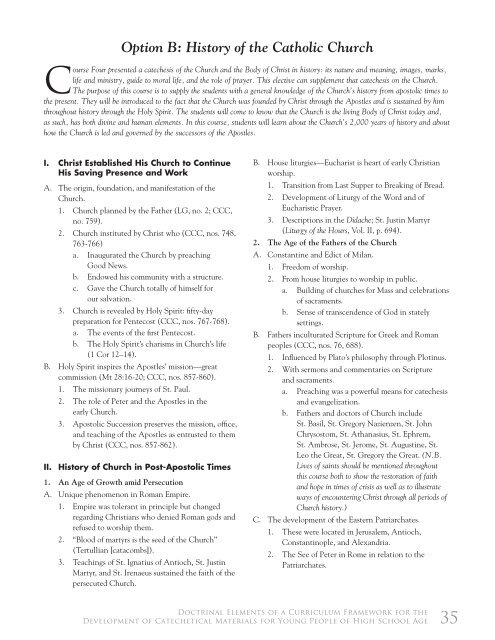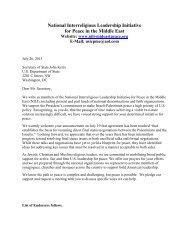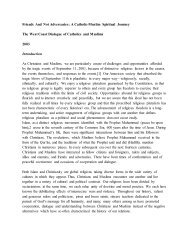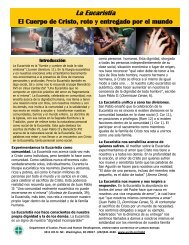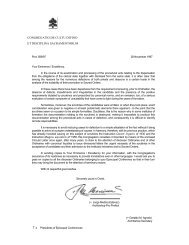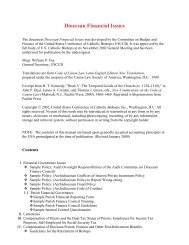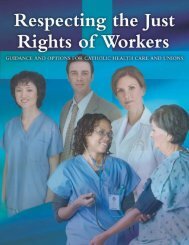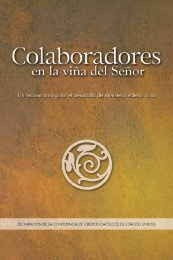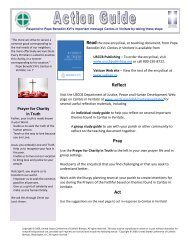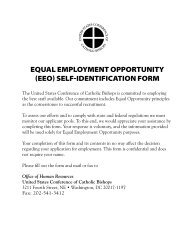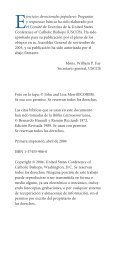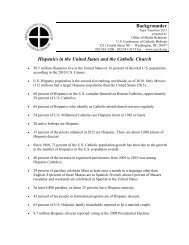Doctrinal Elements of a Curriculum Framework for the Development ...
Doctrinal Elements of a Curriculum Framework for the Development ...
Doctrinal Elements of a Curriculum Framework for the Development ...
- No tags were found...
Create successful ePaper yourself
Turn your PDF publications into a flip-book with our unique Google optimized e-Paper software.
Option B: History <strong>of</strong> <strong>the</strong> Catholic ChurchCourse Four presented a catechesis <strong>of</strong> <strong>the</strong> Church and <strong>the</strong> Body <strong>of</strong> Christ in history: its nature and meaning, images, marks,life and ministry, guide to moral life, and <strong>the</strong> role <strong>of</strong> prayer. This elective can supplement that catechesis on <strong>the</strong> Church.The purpose <strong>of</strong> this course is to supply <strong>the</strong> students with a general knowledge <strong>of</strong> <strong>the</strong> Church’s history from apostolic times to<strong>the</strong> present. They will be introduced to <strong>the</strong> fact that <strong>the</strong> Church was founded by Christ through <strong>the</strong> Apostles and is sustained by himthroughout history through <strong>the</strong> Holy Spirit. The students will come to know that <strong>the</strong> Church is <strong>the</strong> living Body <strong>of</strong> Christ today and,as such, has both divine and human elements. In this course, students will learn about <strong>the</strong> Church’s 2,000 years <strong>of</strong> history and abouthow <strong>the</strong> Church is led and governed by <strong>the</strong> successors <strong>of</strong> <strong>the</strong> Apostles.I. Christ Established His Church to ContinueHis Saving Presence and WorkA. The origin, foundation, and manifestation <strong>of</strong> <strong>the</strong>Church.1. Church planned by <strong>the</strong> Fa<strong>the</strong>r (LG, no. 2; CCC,no. 759).2. Church instituted by Christ who (CCC, nos. 748,763-766)a. Inaugurated <strong>the</strong> Church by preachingGood News.b. Endowed his community with a structure.c. Gave <strong>the</strong> Church totally <strong>of</strong> himself <strong>for</strong>our salvation.3. Church is revealed by Holy Spirit: fifty-daypreparation <strong>for</strong> Pentecost (CCC, nos. 767-768).a. The events <strong>of</strong> <strong>the</strong> first Pentecost.b. The Holy Spirit’s charisms in Church’s life(1 Cor 12–14).B. Holy Spirit inspires <strong>the</strong> Apostles’ mission—greatcommission (Mt 28:16-20; CCC, nos. 857-860).1. The missionary journeys <strong>of</strong> St. Paul.2. The role <strong>of</strong> Peter and <strong>the</strong> Apostles in <strong>the</strong>early Church.3. Apostolic Succession preserves <strong>the</strong> mission, <strong>of</strong>fice,and teaching <strong>of</strong> <strong>the</strong> Apostles as entrusted to <strong>the</strong>mby Christ (CCC, nos. 857-862).II. History <strong>of</strong> Church in Post-Apostolic Times1. An Age <strong>of</strong> Growth amid PersecutionA. Unique phenomenon in Roman Empire.1. Empire was tolerant in principle but changedregarding Christians who denied Roman gods andrefused to worship <strong>the</strong>m.2. “Blood <strong>of</strong> martyrs is <strong>the</strong> seed <strong>of</strong> <strong>the</strong> Church”(Tertullian [catacombs]).3. Teachings <strong>of</strong> St. Ignatius <strong>of</strong> Antioch, St. JustinMartyr, and St. Irenaeus sustained <strong>the</strong> faith <strong>of</strong> <strong>the</strong>persecuted Church.B. House liturgies—Eucharist is heart <strong>of</strong> early Christianworship.1. Transition from Last Supper to Breaking <strong>of</strong> Bread.2. <strong>Development</strong> <strong>of</strong> Liturgy <strong>of</strong> <strong>the</strong> Word and <strong>of</strong>Eucharistic Prayer.3. Descriptions in <strong>the</strong> Didache; St. Justin Martyr(Liturgy <strong>of</strong> <strong>the</strong> Hours, Vol. II, p. 694).2. The Age <strong>of</strong> <strong>the</strong> Fa<strong>the</strong>rs <strong>of</strong> <strong>the</strong> ChurchA. Constantine and Edict <strong>of</strong> Milan.1. Freedom <strong>of</strong> worship.2. From house liturgies to worship in public.a. Building <strong>of</strong> churches <strong>for</strong> Mass and celebrations<strong>of</strong> sacraments.b. Sense <strong>of</strong> transcendence <strong>of</strong> God in statelysettings.B. Fa<strong>the</strong>rs inculturated Scripture <strong>for</strong> Greek and Romanpeoples (CCC, nos. 76, 688).1. Influenced by Plato’s philosophy through Plotinus.2. With sermons and commentaries on Scriptureand sacraments.a. Preaching was a powerful means <strong>for</strong> catechesisand evangelization.b. Fa<strong>the</strong>rs and doctors <strong>of</strong> Church includeSt. Basil, St. Gregory Nazienzen, St. JohnChrysostom, St. Athanasius, St. Ephrem,St. Ambrose, St. Jerome, St. Augustine, St.Leo <strong>the</strong> Great, St. Gregory <strong>the</strong> Great. (N.B.Lives <strong>of</strong> saints should be mentioned throughoutthis course both to show <strong>the</strong> restoration <strong>of</strong> faithand hope in times <strong>of</strong> crisis as well as to illustrateways <strong>of</strong> encountering Christ through all periods <strong>of</strong>Church history.)C. The development <strong>of</strong> <strong>the</strong> Eastern Patriarchates.1. These were located in Jerusalem, Antioch,Constantinople, and Alexandria.2. The See <strong>of</strong> Peter in Rome in relation to <strong>the</strong>Patriarchates.<strong>Doctrinal</strong> <strong>Elements</strong> <strong>of</strong> a <strong>Curriculum</strong> <strong>Framework</strong> <strong>for</strong> <strong>the</strong><strong>Development</strong> <strong>of</strong> Catechetical Materials <strong>for</strong> Young People <strong>of</strong> High School Age35


